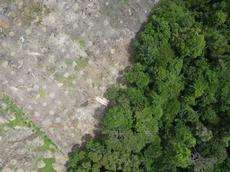Drone in action for the rainforest

Vast areas of Indonesia’s rainforests are being destroyed by logging and conversion to oil palm plantations. In this Southeast Asian country, deforestation has reached alarming levels.
Lian Pin Koh, an assistant professor of Applied Ecology and Conservation at ETH Zurich, took it upon himself to develop inexpensive drones that local conservation workers can use for mapping and monitoring land use change in Indonesia.
Fifty hectares covered per flight
Koh’s drone is a do-it-yourself solution that costs less than 2,000 dollars. Commercial drones cost anything between 10,000 and 50,000 dollars – too much for the tight budget of environmentalists or conservation biologists in many tropical developing countries. The researcher mounted a camera on the unmanned autonomous aircraft to film and photograph the world from up above.
The drone flies autonomously along a pre-programmed route via a Google Map interface. Koh only takes manual control of the drone when landing in small spaces to avoid obstacles. The model aeroplane can stay in the air for twenty-five minutes and cover an area of fifty hectares during a single flight.
He came up with idea of deploying low-cost drones for nature conservation research back in 2004 while he was conducting fieldwork in Borneo. However, it was not until 2011 that he was able to realise his project in collaboration with orang-utan expert Serge Wich from the University of Zurich and PanEco. Together, they came up with the idea of using drones to survey the apes and their nests in trees.
Initial tests successful
In February 2012 Koh and Wich tested their low-cost drones for the first time under tropical conditions. The plane flew over thirty scouting expeditions over forests near the Gunung Leuser National Park in Sumatra – without crashing once. “We are delighted that the test flights were so successful,” says Koh.
The images and videos recorded by cameras attached to the drone’s underbelly are excellent. Highlights of the test flights include an orang-utan foraging for food in a tree and elephants on the ground. However, the scientists could also see the extent of the deforestation and palm oil plantations on the images, and make out a plume of smoke in the forest, which is a telltale sign of an open fire.
Koh’s drone to film penguins?
The researchers are now in the process of stitching the images to produce land cover maps for the study location. They have also uploaded the videos on Youtube so that other researchers can view them. “Our videos have already yielded interested enquiries from all over the world. We were even asked to test the drone in projects in Borneo, Africa and even to survey penguins in the Antarctic,” says the assistant professor from ETH Zurich.
Low-cost drones are not only an affordable alternative to expensive commercial drones, but also to satellite images, which scientists often work with to produce land use maps. However, satellite-based images are often expensive and out-dated. “Drones provide us with images in real time and can fly the same routes repeatedly within a short space of time,” says Koh, underlining the advantages of the unmanned aircraft.
The scientist from ETH Zurich envisions that low-cost reconnaissance drones will become part of every conservation biologist’s toolkit as they enable areas that are inaccessible or difficult to reach on foot to be monitored. “The drone costs no more than a decent pair of binoculars,” stresses Koh.
Provided by ETH Zurich



















